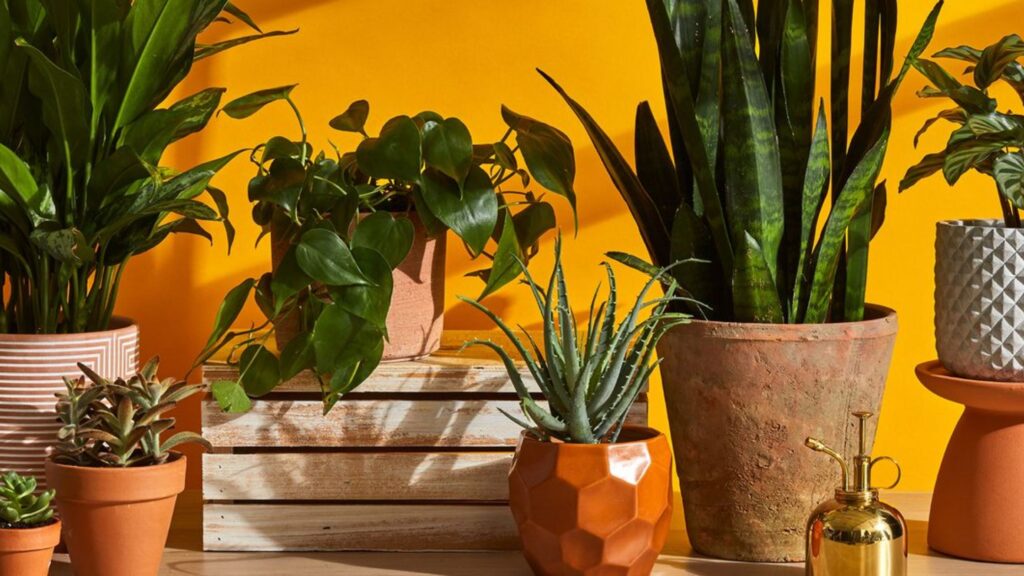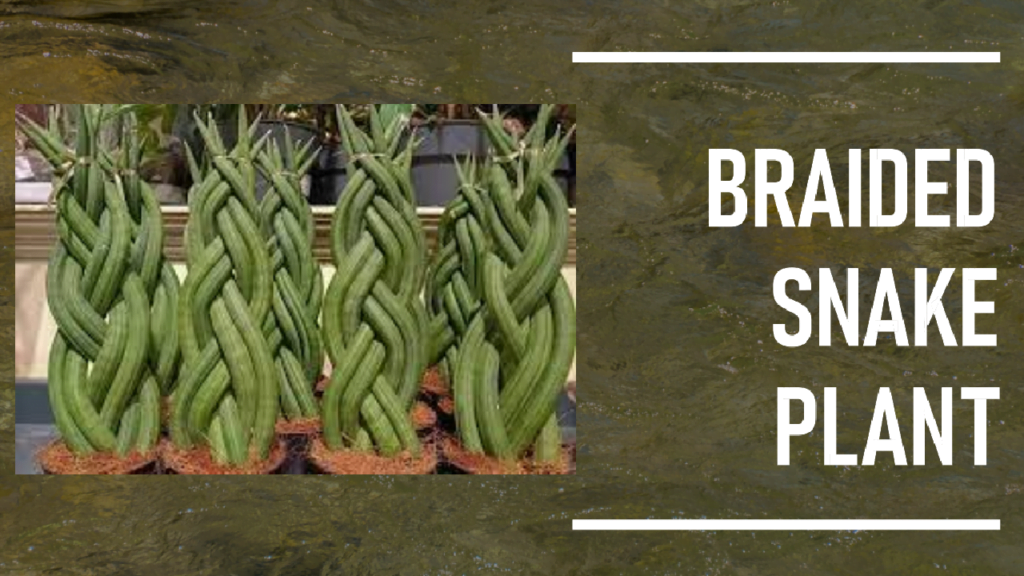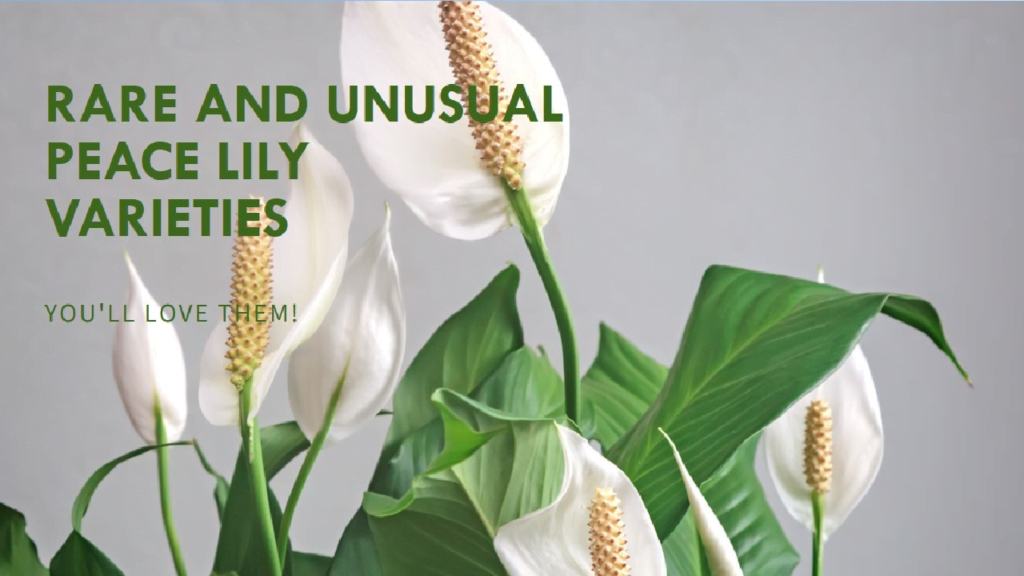These are the greatest indoor plants for low light! If you need to brighten up a dark nook or bring some life into your basement, one of these stunning low light plants will do the trick. Here are some plants that flourish without sunlight and how to care for them.
Adding plants to the house is my favorite method to brighten up any space. The presence of plants makes everything feel lighter, brighter, and more alive. Houseplants give color and texture to a room, filter the air, and simply look lovely, whether you are a beginner plant parent or a seasoned plant owner.
Best Indoor Plants for Dark Rooms
When it comes to sunshine exposure, different houseplants have varied requirements. A houseplant that needs full daylight will not flourish in a dark room, while a houseplant that wants less light will not thrive in a bright room.
The following plants grow well in low light circumstances and require little to no upkeep, making them excellent for both novices and those who want to produce attractive plants without putting in too much effort.
1. Ivy Plant
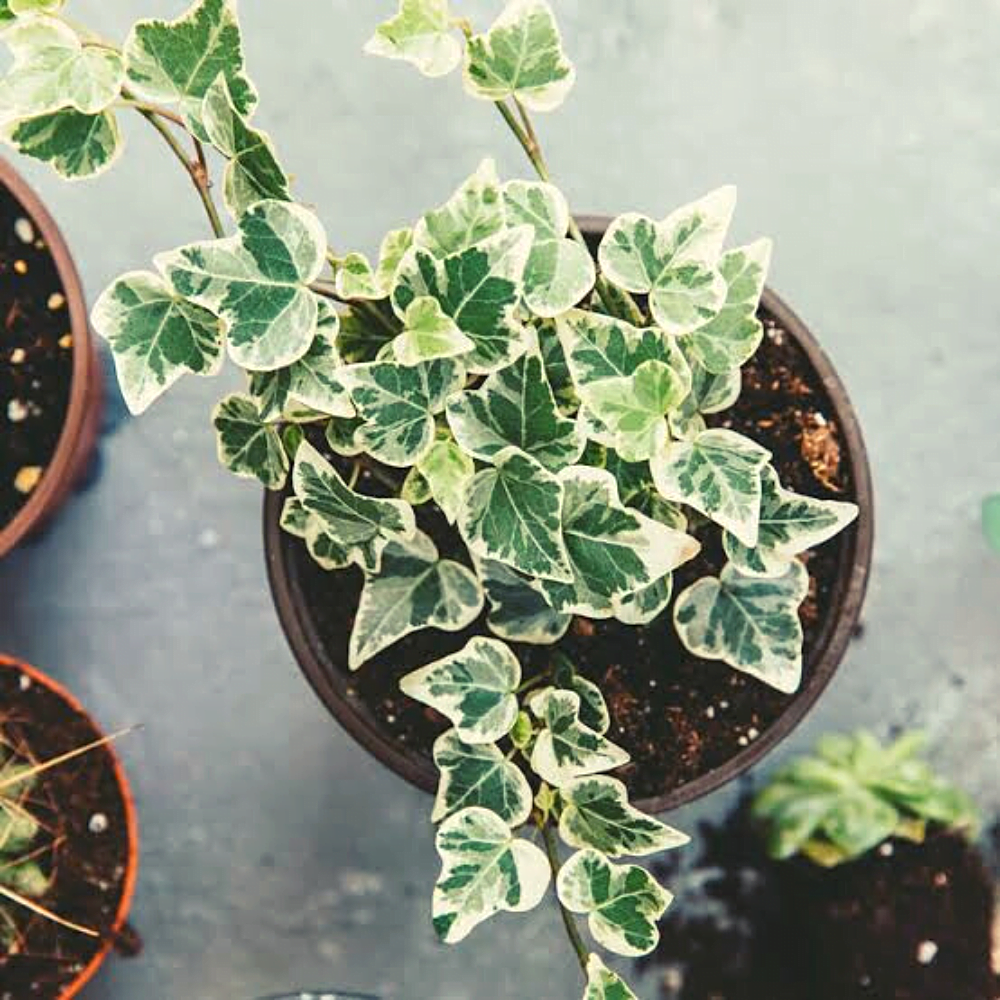
A classic plant that adds elegance to any setting is ivy. This plant enjoys climbing and just requires a small amount of daily sunlight.
- The English and Algerian variants thrive in low light conditions.
- According to NASA, English Ivy is a top air-purifying plant. Toxins such as benzene, formaldehyde, xylene, and toluene can be removed, as well as fecal matter and mold particles.
2. Snake Plant
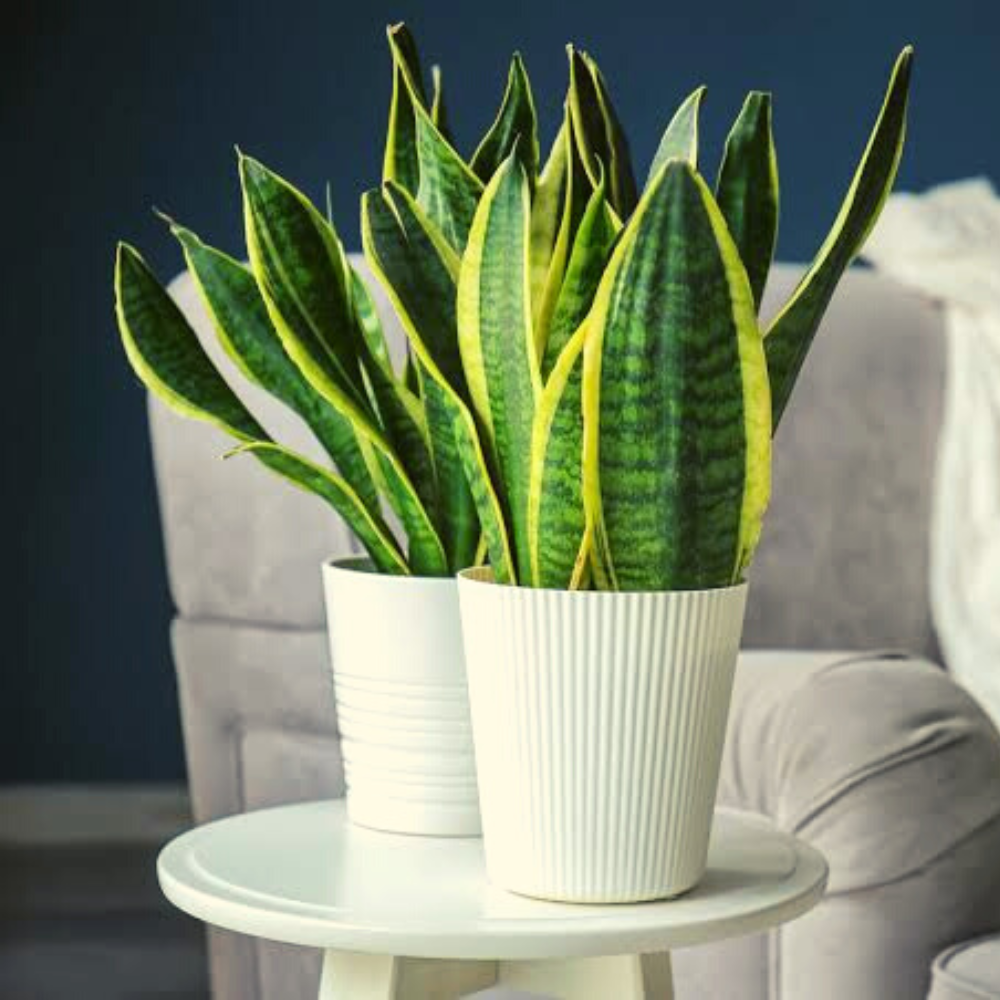
A well-liked low-light plant that can be planted anywhere in the house is the snake plant. Avoiding direct sunlight will encourage the plant’s healthy growth for many years. These indoor plants are ideal for residences and workplaces with little to no natural light.
- This slow-growing shrub is known for its erect and pointed leaves.
- The Snake Plant is adaptable and tolerant, requiring only 2-6 weeks of watering.
- The snake plant is one of the best plants for purifying the air of benzene, formaldehyde, and other toxins.
3. Maidenhair Fern
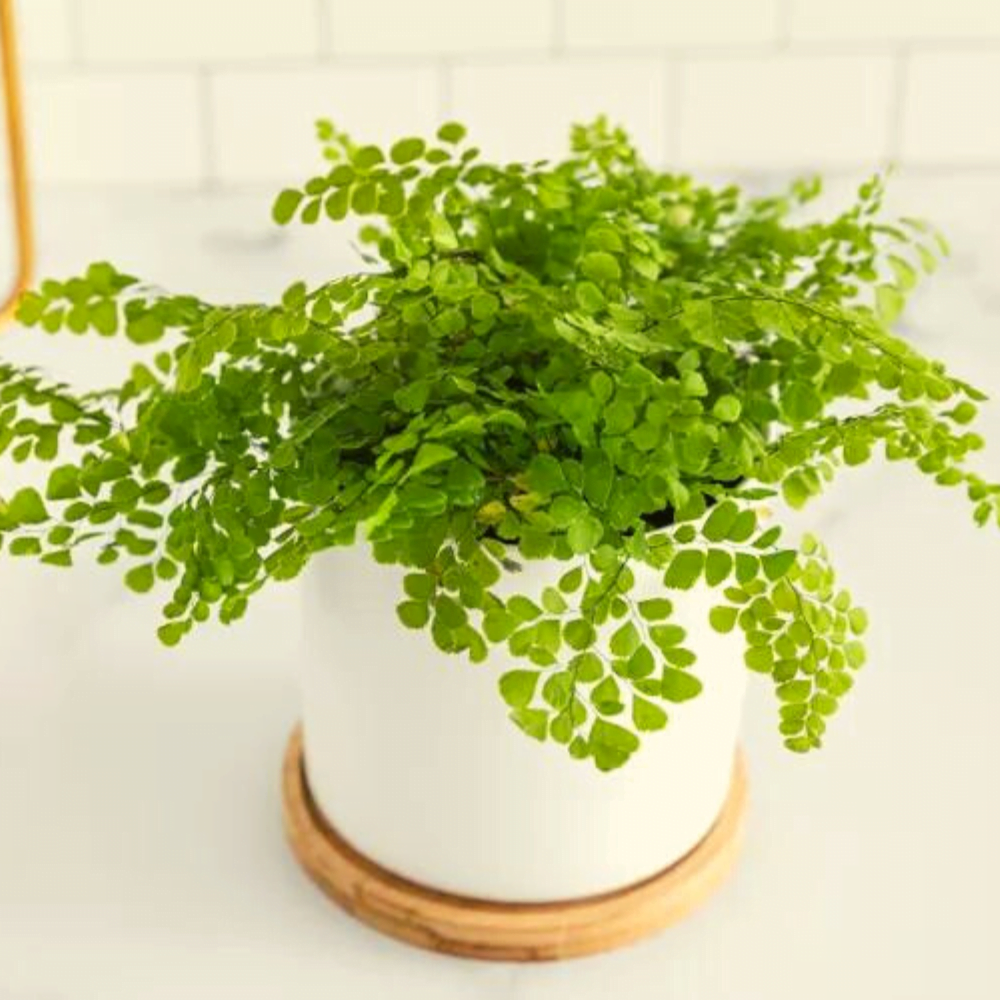
The northern maidenhair fern is a fragile and wispy plant with light and feathery foliage. It is also called the five-fingered fern due to its several narrow fronds that are arranged on a black stem.
One to five hours of natural light per day are plenty for this ethereal species, who prefers partial to full shade.
- Many ferns thrive in low light.
- Maidenhair ferns thrive in low light situations.
- Have a rich appearance, making them ideal for adding green to any home.
4. Pothos

Pothos are low-maintenance plants that do not require a lot of fuss to thrive indoors. They can thrive in low light conditions and with sporadic watering.
- This plant, sometimes known as Devil’s ivy, can absorb harmful poisons such as formaldehyde.
- They can grow up to 10 feet tall and look great in hanging baskets or as climbing plants.
5. Philodendron
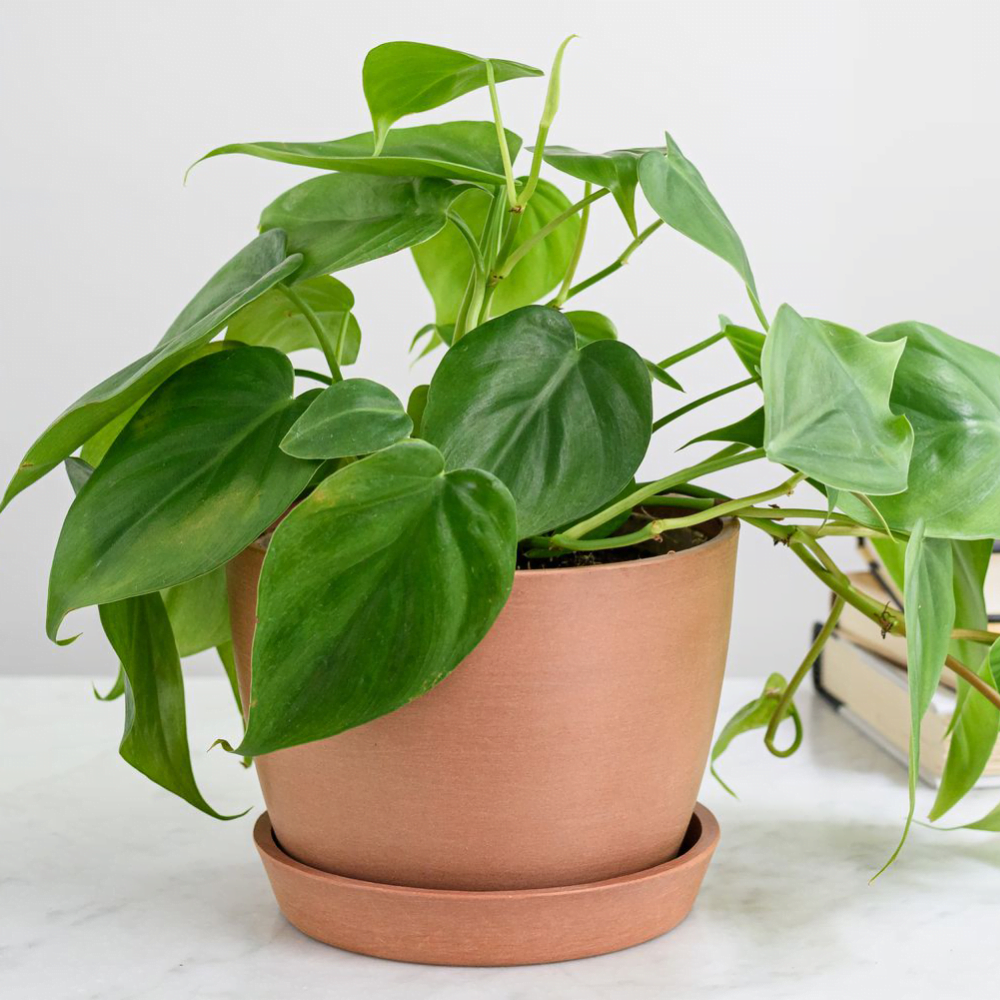
Although it is advised against keeping philodendrons in direct sunlight because it might result in brown burn marks on their leaves, they do well in moderate to bright light. According to one’s needs and the amount of available space, one can pick among shrub-like and vining kinds of philodendrons.
- Philodendron is a well-known houseplant that thrives in medium to low light levels.
- They grow without a lot of attention, making them an excellent choice for beginners.
6. Rex Begonia

They don’t have aggressive blooming habits, can handle less light than other begonias, and do well with fluorescent lighting.
- Rex Begonia is an excellent choice for gorgeous indoor plants that don’t require a lot of care.
- This plant is well-recognized for its colorful leaves and distinct appearance, which is why it is such a popular option among plant owners.
- Rex Begonia plants thrive in both medium and low light conditions.
7. Calathea
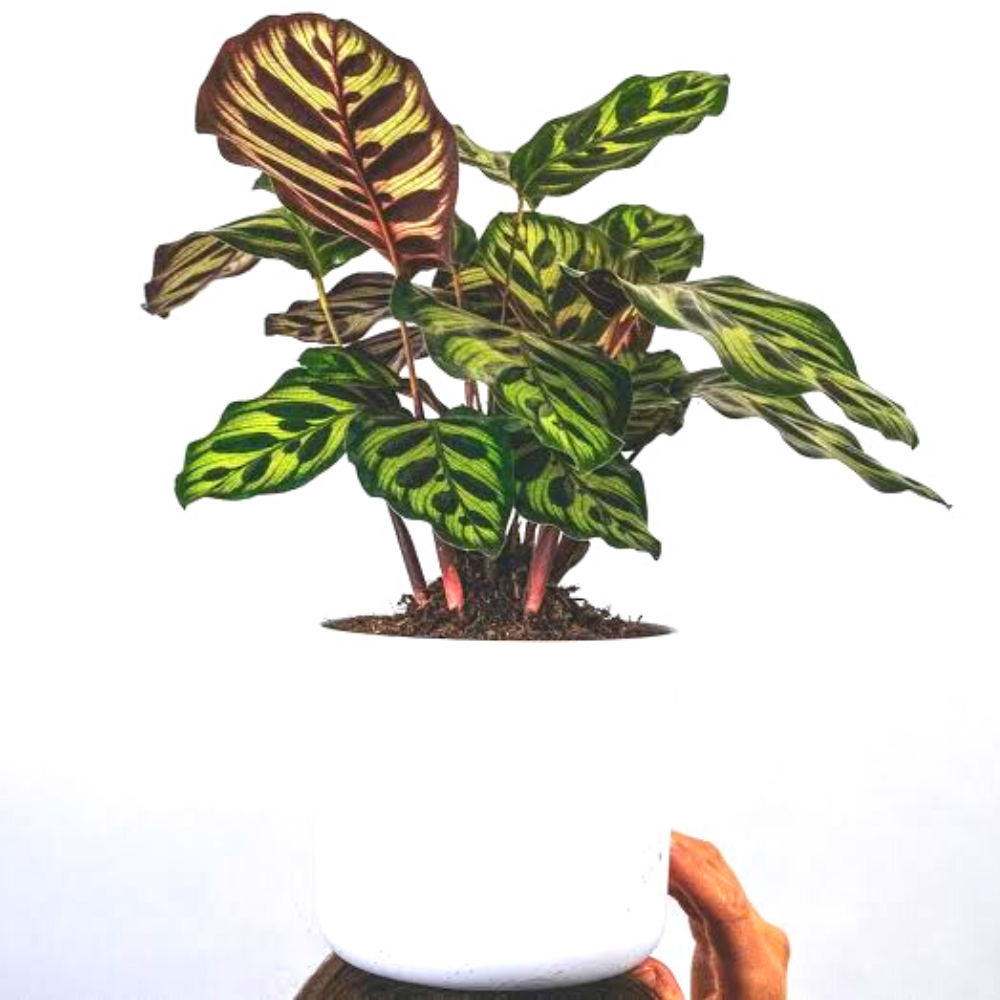
For darker environments, calathea are lovely, bushy indoor plants that can reach a height of 50 cm. They would even be excellent plants for darker bathrooms because they enjoy high humidity.
- Calathea plants demand slightly more care than an ordinary houseplant.
- They require a continuous amount of moisture to survive, but they do not require sunlight, therefore they can thrive in low light circumstances.
8. Spider Plant

One of the most adaptive indoor plants, the spider plant can endure a long period of subpar lighting.
- Due to their distinctive appearance and ease of care, spider plants are among the most popular indoor plants.
- They can survive in low light and indirect light, which makes them ideal for dimly lit spaces.
9. Peace Lily

Even when it is grown in low light, the common flowering plant known as the peace lily blooms several times a year. It can also grow in medium light, but growth won’t be hindered by low light, so don’t worry about that.
- Even when it is grown in low light, the common flowering plant known as the peace lily blooms several times a year.
- Although it can also thrive in medium-light environments, growth won’t be hampered by low light levels.
10. Lucky Bamboo

The lucky bamboo is a dark room plant that you can simply purchase from the neighbouring nursery, and it is the plant that is thought to bring good fortune. The fact that this plant doesn’t require much light is the nicest aspect. Even in dimly lit spaces, it can still flourish comfortably. Additionally, you may use this little plant as decor on your coffee table and desk at work.
- Lucky bamboo has a distinctive appearance and doesn’t require much care to grow and prosper.
- It thrives in both medium and low light conditions and only needs water to flourish if you don’t feel like setting up a pot or planter.
Best Indoor Plants for Dark Rooms
1. Ivy
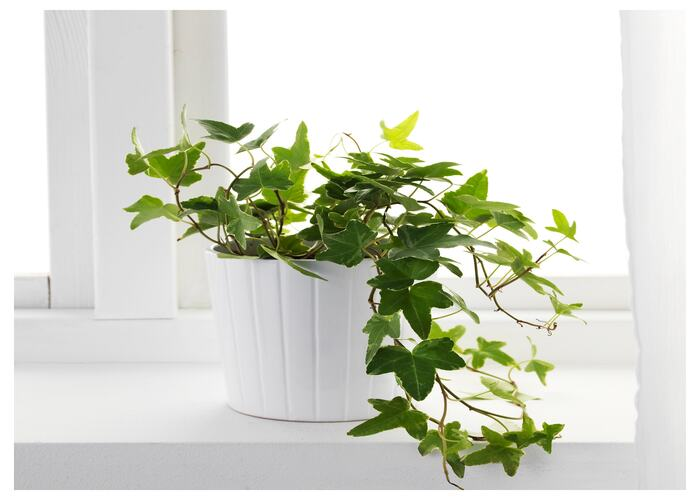
Ivy can grow beautifully inside in bright light. It can develop into something that resembles the outdoors by becoming long and luxurious. As long as you understand what an ivy plant needs to thrive, growing ivy inside is simple.
Indoor Ivy Growth
Ivy may be grown successfully indoors as long as you give it what it requires. Light is the most crucial aspect of caring for indoor ivy plants. All genuine ivies require intense light.
Variegated cultivars can tolerate medium light, but be mindful that under lower light levels, their variegation will be less noticeable. Ivy plants will grow lanky and sickly-looking inside if there is not enough light. They will be more vulnerable to pests as well.
Care for Indoor Ivy Plants
Always examine the soil before adding water to your ivy when watering it. Before you water your ivy plant again, let the soil dry up a bit so that it is touchably dry on top. Ivies love to be kept on the somewhat dry side.
Ivy dislikes being in standing water or extremely moist soil, so make sure your plant has great drainage as well.
Regular fertilizing is another aspect of ivy plant care. Use a water-soluble, nitrogen-rich fertilizer to feed your ivy roughly once a month in the spring, summer, and fall. In the winter, when the ivy is dormant, avoid fertilizing because it could be detrimental to the plant’s health.
2. Snake Plant

How to Grow a Snake Plant
It’s not too difficult to grow snake plants from cuttings. The most crucial thing to keep in mind is that they are susceptible to rot, which necessitates the use of soil with good drainage.
The typical technique of propagating snake plants is by leaf cuttings, but dividing them is probably the simplest approach.
A sharp knife may easily be used to cut the fleshy rhizomes from the roots and pot them up. Once more, these must be planted in soil with good drainage.
Care for Snake Plants
After they have been reproduced, snake plants require very little maintenance. Don’t overwater them, especially in the winter, and place them in indirect sunlight.
In actuality, allowing these plants to dry out a bit between waterings is preferable. If the plants are in pots, you can use a small amount of all-purpose fertilizer, but that’s about it.
3. Maidenhair Fern
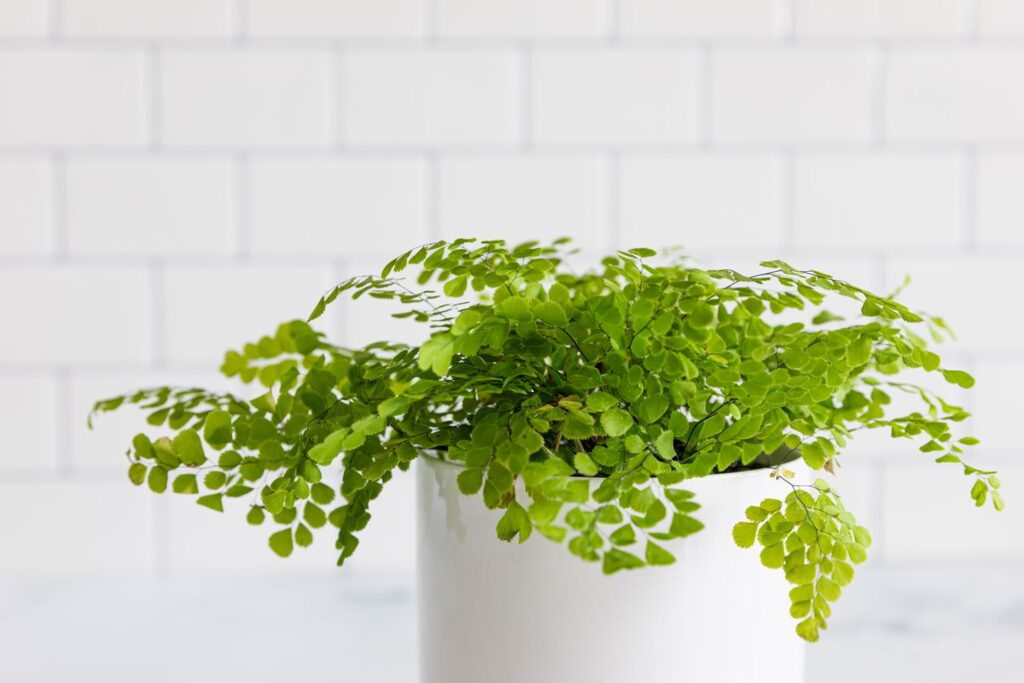
Growing Maidenhair Ferns
It’s simple to learn how to grow maidenhair fern indoors or in the garden. The plant prefers moist but well-draining soil that has been treated with organic matter, much as in its natural environment in humus-rich woodlands, and normally grows in moderate to full shade.
These ferns can’t stand dry ground. While maidenhair ferns prefer a more alkaline soil pH, most ferns thrive in slightly acidic soils. To help with this, mix some ground limestone into your outdoor beds or the potting mix for plants grown in containers.
The maidenhair fern does not want to be replanted and loves small containers when grown indoors. When cultivated inside, maidenhair is also sensitive to low humidity levels and dry air from ventilation systems.
As a result, you will either need to spritz the plant every day or place it in a tray filled with water and pebbles.
Care for Maidenhair Fern
Maidenhair fern maintenance is not extremely difficult. As part of its maidenhair fern care, it must be maintained moist, but you must be careful not to overwater the plant. Root and stem rot may result from this.
On the other hand, avoid allowing the maidenhair to become dry. Don’t be hasty to toss it away if it does unintentionally dry out. The maidenhair fern will ultimately sprout new leaves if you give it a good soak.
4. Pothos
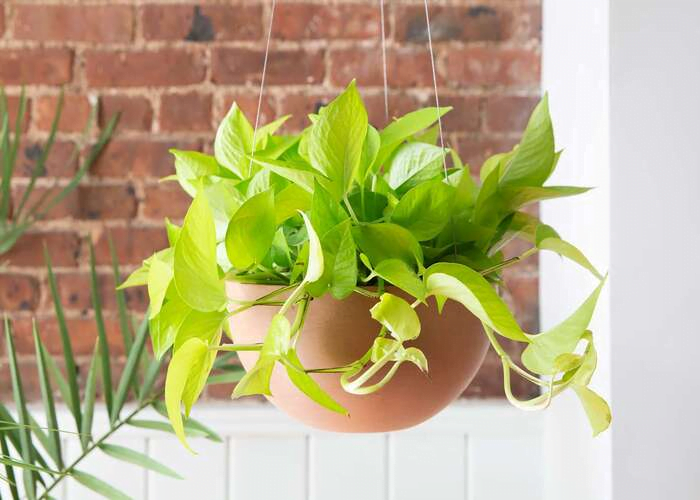
Maintaining Pothos Plants
The upkeep of a pothos is quite simple. These plants thrive in a variety of settings. They can be cultivated in dry soil or water-filled containers, and they thrive in both low and bright indirect light. They perform almost as well in nutrient-poor soil as they do in nutrient-rich soil.
As they can thrive in low light conditions, pothos plants are an excellent addition to your bathroom or office. Pothos do well in a range of lighting situations, but they struggle in direct sunshine.
Do Pothos Plants Have Poison?
Although pothos plants are low-maintenance indoor plants, you should be aware that they are poisonous. Although seldom dangerous, ingesting the plant can irritate the stomach and result in vomiting because of the calcium oxalates it contains.
Highly sensitive people may develop a rash even from the plant’s sap. Although it is harmful to cats, dogs, and children, as previously indicated, it typically only causes severe illness rather than death.
5. Philodendron
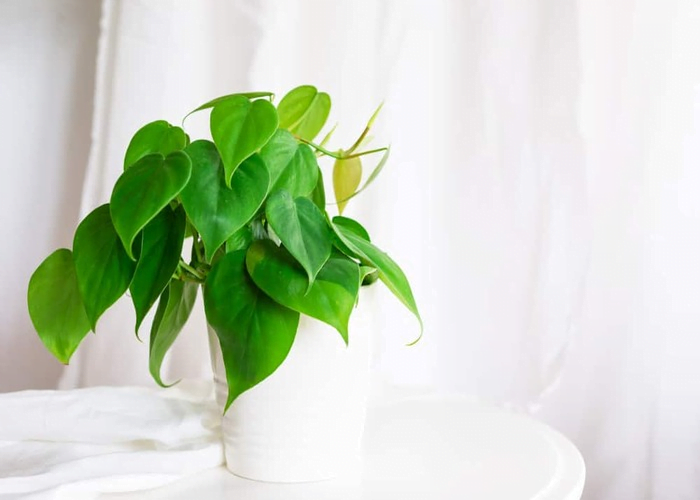
Care Instructions for a Philodendron The three fundamental requirements for philodendron maintenance are light, water, and fertilizer.
Sunlight –
Place the plant in a spot that receives strong, indirect light. Locate a spot next to a window where the sun never actually touches the vegetation. Older leaves naturally turn yellow as they age, but if several of them do so at once, the plant may be receiving too much light.
On the other side, the plant is probably not getting enough light if the stems are long and lanky and there are several inches between each leaf.
Water –
Allow the top inch (2.5 cm) of soil to dry out between waterings for cultivating philodendron plants. A good approach to check the moisture level in the soil is to stick your finger in it. Your index finger extends approximately one inch (2.5 cm) past your first knuckle.
If the plant’s leaves are drooping, it may be receiving too much or not enough water. However, when you adjust the watering schedule, the leaves recover fast.
A fertilizer –
Give philodendron houseplants a balanced, macronutrient-rich liquid foliage fertilizer to use. Every month in the spring and summer, as well as every six to eight weeks in the fall and winter, water the plant with fertilizer.
The plant is trying to inform you that it isn’t getting enough fertilizer by growing slowly and having little leaves. Pale new leaves typically signify a lack of calcium and magnesium, two crucial micronutrients for philodendrons.
6. Rex Begonia
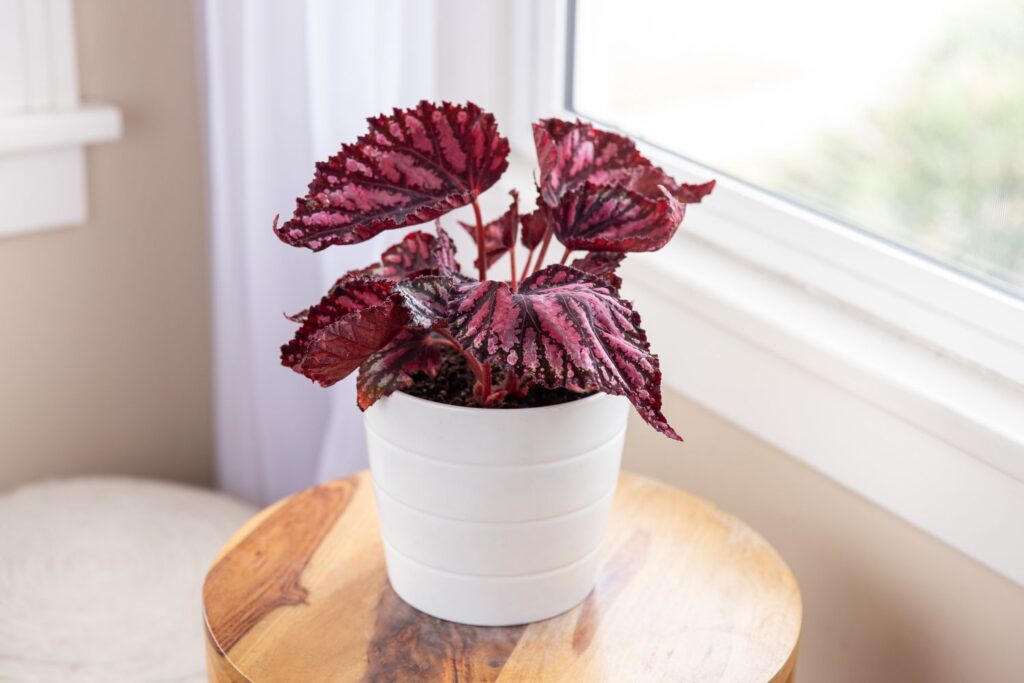
Rex Begonias are prized for having stunning foliage. The cultivar features a broad array of hues, textures, and shapes. Its leaves can take on a variety of shapes, including hearts, seashell swirls, ivy-like formations, and more.
The Rex Begonia is distinguished by its vivid hues, which are frequently a combination of green, pink, and burgundy.
They can sometimes have metallic greyish-silver tones. Awe-inspiring to view always! Rex Begonias are friendly, easy-going houseplants that are native to tropical areas and are equally pleasing to the eye.
Basic Care
- Sunlight – indirect light with a range of brightness.
- Water your plants once a week, letting the top inch of soil dry out in between applications.
- Humidity -Can handle dry air, but prefers high humidity. Avoid misting, which can cause powdery mildew issues.
- Temperature – 65° to 75° F is the typical house temperature. The Rex Begonia is comfortable if you’re comfortable.
- Size – A well-maintained Rex Begonia produces up to 6″ long leaves.
7. Calathea
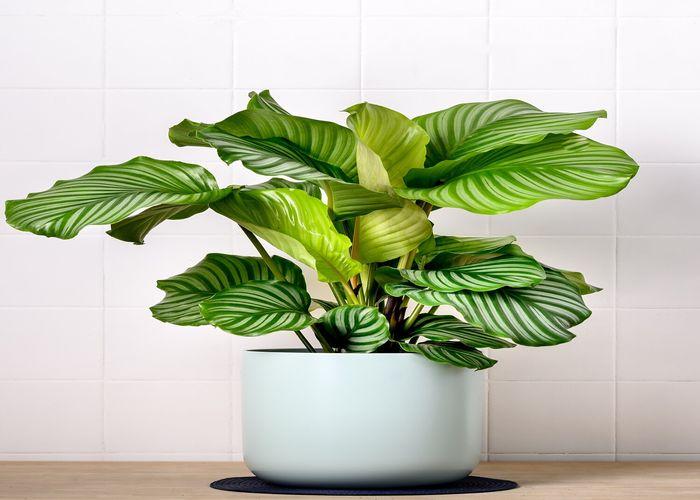
Growing Calathea
Calatheas require particular attention in order to flourish. Keep them out of direct sunlight and provide them with a regularly warm area with bright but indirect light. From spring until fall, keep the soil damp. To add humidity, spritz the leaves every day or stand on a tray of wet pebbles.
Watering calatheas should only be done with filtered, distilled, or rainwater—never with tap water.
Calathea Plant Locations
Calatheas can tolerate some shade but thrive in direct, strong light. Keep away from draughts and direct sunlight, which will scorch the leaves. A minimum of 15°C should be provided, and rooms with frequent temperature changes should be avoided. Calatheas love a humid environment, making bathrooms the perfect place for them.
Taking Care of a Calathea
From spring until autumn, the soil should always be evenly moist (but not drenched), therefore it’s best to water sparingly yet frequently. Calatheas are delicate to the contaminants in tap water, so use distilled water, filtered water, or rainfall.
Verify that any extra water has been drained. Wintertime irrigation is reduced, keeping the soil slightly damp. Calatheas thrive in a humid atmosphere, so spritz the leaves every day with lukewarm water or place them on a tray filled with pebbles or gravel and water.
8. Spider Plant

One of the simplest indoor plants to grow, even for beginners, is the spider plant. Additionally, it’s one of the most fascinating.
With the additional benefit of even longer branches producing plantlets that can be rooted and divided from the parent plant, it has long, narrow leaves that grow in rosettes and hang over the edge of the pot.
Simple requirements for spider plants include:
Place the plant in a room with bright to moderate light and a temperature that is cozy for everyone.
Keep the soil just moist enough. In the spring and summer, watering once a week is adequate; throughout the winter, let the soil dry out a bit more before watering.
Spider plants are among the houseplants that are susceptible to fluoride in tap water. For the plants, think about utilizing rainwater or distilled water. Utilize a balanced houseplant fertilizer as directed by the manufacturer every two to three weeks.
9. Peace Lily

How to Plant, Divide, and Transplant Peace Lilies
Use an all-purpose, well-draining potting soil. The soil has to be able to retain moisture and gradually lose moisture over time. Peace lilies don’t want their soil to completely dry out, but they also won’t thrive in perpetually damp soil because that encourages the growth of the fungus that causes root rot.
The peace lily benefits from repotting every few years in the spring since it will love the new soil. The peace lily can be divided if it becomes too big for its pot at any point.
Split the plant into smaller plants after removing it from the pot, making sure to leave some leaves on each clump. Since peace lilies are rhizome-based plants, they may withstand some rough handling when being divided.
The Peace Lily Plant: Does it Have Poison?
Indeed, peace lilies have low toxicity. Calcium oxalate is present in every part of the peace lily plant and, if consumed in large quantities, can irritate the respiratory system and stomach.
Away from young children and animals who might gnaw on the plant, keep peace lilies. Common plants such as philodendrons, daffodils, real lilies, and hyacinths also contain calcium oxalate.
10. Lucky Bamboo
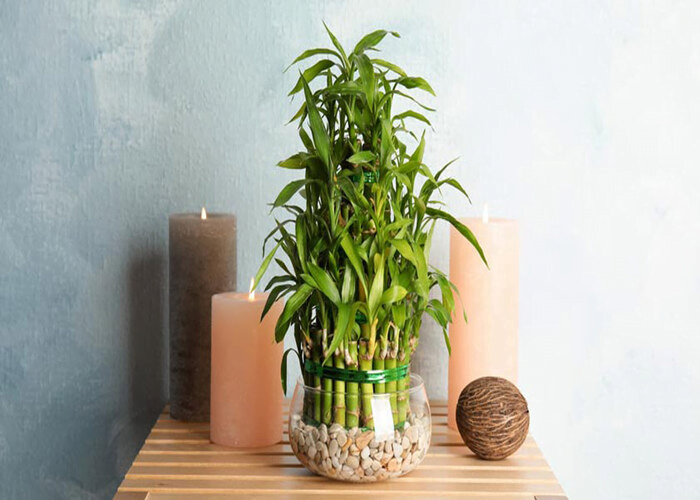
Which Growing Conditions Are Ideal for Lucky Bamboo?
Keep your lucky bamboo plant warm and indoors, preferably in a well-lit room, for the best growing conditions. Lucky bamboo can be grown outdoors in soil, however, it may suffer from cold or direct sunlight.
Care Instructions for Lucky Bamboo
Check out these lucky bamboo plant care suggestions to prolong the life of your plant as much as possible:
- Clear out the developing vessel. To stop algae growth, wash the container every few months and give it fresh water once a week.
- Let it have a lot of light. Due to its tolerance for mild shade and indirect sunshine, lucky bamboo is a fantastic indoor plant. However, intense light will cause your bamboo to expand in size. This doesn’t imply that you should place your plant in full sunlight, but it does imply that maintaining it in a bright setting can lengthen its life.
- Purify your water. Both soil and water can be used to grow lucky bamboo. Filtered or distilled water is your best bet for keeping the roots of your bamboo plant moist and strong if you’re growing it in water. Chemicals in tap water have the potential to burn the plant’s stalks. If you need to water your plant, always use clean water.
- Pick the appropriate container. A fortunate bamboo plant typically arrives in its container when you purchase or receive one, frequently atop pebbles or pearls. You might need to move your bamboo into a new container if it outgrows the one it was originally planted in. Dig up the bamboo plant gently, then transfer it to a new pot after washing the pebbles.
- Add the bamboo plant, making sure the roots are entirely hidden by the pebbles by carefully re-burying them there. Don’t let the water level go so high that it wets the bamboo stalks; just enough to cover the roots.
- Have adequate drainage. Make sure the container for your lucky bamboo has sufficient drainage if it is growing in soil. Although lucky bamboo enjoys moist soil, too much watering might have a detrimental effect on the plant’s development. When the soil’s top inch is dry, water the area.
Advice on Arrangement
One portable garden will brighten up any dim area and improve your day, so free up some space at your desk for one.
Are you ready to adopt a new plant child? Visit our shop to purchase the ideal planter for your flat with poor lighting! The top planters available are what we carry.
Designing a home or garden benefits greatly from the knowledge of plant texture. When deciding on your design theme, look over this post.
Check out our planting guide if you are brand-new to the planting game. We can help you with all aspects of indoor plant care, from growing to keeping them!
Related Articles
- 15 Best Plants for Front Door Entrance India | Auspicious plants for front door
- 10+ Money plant Benefits That Will Make you Keep It In Your House
- Are Spider Plants Toxic to Cats?- 4 Ways To Prevent Your Cats From Eating Spider Plants.
- Best Plants for the House – 8 Top Apartment Plants That You Can’t Miss
- How to Braid Your Snake Plant: Tips and Care Guide
- 20+ Rare and Unusual Peace Lily Varieties You’ll Love



